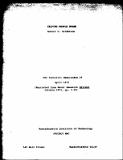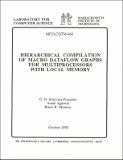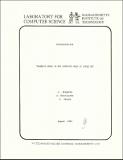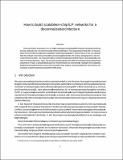Browsing LCS Publications by Title
Now showing items 486-505 of 1163
-
Hardware Estimatino of a Process' Primary Memory Requirements
(1977-01)It is shown that a process' primary memory requirements can be approximated by use of the miss rate in the Honeywell 6180's page table word associative memory. This primary memory requirement estimate was employed by an ... -
Hardware Mechanisms for Memory Integrity Checking
(2002-11)Memory integrity verification is a useful primitive when implementing secure processors that are resistant to attacks on hardware components. This paper proposes new hardware schemes to verify the integrity of untrusted ... -
Helping People Think
(1971-04)Everyone, today, is familiar with the use of machines to ease physical burdens. Since the dawn of civilization, man's progress in gaining control over his environment has been largely determined by the power and sophistication ... -
A Heuristic Approach to Alternate Routing in a Job Shop
(1965-06)The research reported here investigates the use of heuristics for selecting from several alternate routes resulting from partially ordered tasks in a job shop order file. The experimental vehicle employed was digital ... -
Hierarchical Compilation of Macro Dataflow Graphs for Multiprocessors with Local Memory
(1992-10)This paper presents a hierarchical approach for compiling macro dataflow graphs for multiprocessors with local memory. Macro dataflow graphs comprise several nodes (or macros operations) that must be executed subject to ... -
Hierarchical Compilation of Macro Dataflow Graphs for Multiprocessors with Local Memory
(1992-12)This paper presents a hierarchical approach for compiling macro dataflow graphs for multiprocessors with local memory. Macro dataflow graphs comprise several nodes (or macros operations) that must be executed subject to ... -
Hierarchical Correctness Proofs for Distributed Algorithms
(1987-04)This thesis introduces a new model for distributed computation in asynchronous networks, the input-output automaton. This simple, powerful model captures in a novel way the game-theoretical interaction between a system ... -
Hierarchical Inequality Reasoning
(1987-02)This paper describes a program called BOUNDER that proves inequalities between elementary functions over finite sets of constraints. Previous inequality algorithms perform well on some subset of the elementary functions, ... -
High Level Expression of Semantic Integrity Specifications in a Relational Data Base System
(1976-09)The "semantic integrity" of a data base is said to be violated when the data base ceases to represent a legitimate configuration of the application environment it is intended to model. In the context of the relational ... -
High Level VAL Constructs in a Static Data Flow Machine
(1981-06)The Dennis-Misunas Form 1 Data Flow Machine can best be described as a static and scalar machine. Despite these two limiting characteristics, it is still possible to translate the whole of the functional programming ... -
A High-level Signal Processing Programming Language
(1988-03)The motivations for an abstract, diagrammatic signal processing language are presented along with a study of the semantics that such language should have. D-PICT, the proposed Digital Signal Processing Pictorial Language, ... -
High-Performance All-Software Distributed Shared Memory
(1996-02)The C Region Library (CRL) is a new all-software distributed shared memory (DSM) system. CRL requires no special compiler, hardware, or operating system support beyond the ability to send and receive messages between ... -
A High-performance Retargetable Simulator for Parallel Architectures
(1991-06)The complexity of the interaction between software and hardware in MIMD machines makes experimental evaluation of parallel programs an import complement to theoretical analysis. Traditional techniques used to monitor the ... -
A History of CLU
(1993-09)The idea of a data abstraction has had a significant impact on the development of programming languages and on programming methodology. CLU was the first implemented programming language to provide direct linguistic support ... -
Hoare's Logic Is Not Complete When It Could Be
(1982-08)It is known (cf.[2]) that is the Hoare rules are complete for a first-order structure A, then the set of partial correctness assertions true over A is recursive in the first-order theory of A. We show that the converse is ... -
How Can We Compute with Arrays of Nanstructures?
(1994-08)In part the goal of the Ultra Program is to extract useful computation from nanometer scale effects. To accomplish this goal those of us who are computer scientists must communicate clearly to those of you who are chemists ... -
How to Assemble Tree Machines
(1984-03)Many researchers have proposed that ensembles of processing elements be organized as trees. This paper explores how large tree machines can be assembled efficiently from smaller components. A principal constraint considered ... -
How to Build Scalable On-Chip ILP Networks for a Decentralized Architecture
(2000-04)The era of billion transistors-on-a-chip is creating a completely different set of design constraints, forcing radically new microprocessor archiecture designs. This paper examines a few of the possible microarchitectures ... -
How to Construct Random Functions
(1982-11)We assume that functions that are one-way in a very weak sense exist. We prove that in probabilitic polynomial time it is possible to construct deterministic polynomial time computable functions g:{1,…,2^k} -> {1,…,2^k} ... -
How to Share a Secret
(1979-05)In this paper we show how to divide data D into n pieces in such a way that D is easily reconstructable from any k pieces, but even complete knowledge of k-1 pieces reveals absolutely no information about D. This technique ...



















